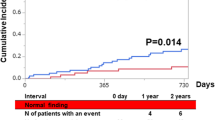Abstract
Background
There is speculation that coronary angiography may be oversued for the assessment of coronary artery disease. Because of its proved ability to differentiate high- and low-risk subsets of patients with coronary artery disease, myocardial perfusion scintigraphy should be an effective strategy in patient selection for angiography. This retrospective clinical study analyzed the relation between scintigraphic findings and subsequent angiography.
Methods and Results
Coronary angiographic rates were determined by following up on all stress single-photon emission computed tomographic (SPECT) myocardial perfusion studies performed in a cardiology practice nuclear laboratory during a 26-month interval. All patients were followed up for at least 3 months; mean follow-up was 8.9 months. Subsequent angiography was determined from catheterization laboratory logs, medical records, and telephone contact. Scintigraphic studies were graded according to presence or absence of reversible perfusion defects, affected coronary territories, and lung uptake of 201Tl. Scans were categorized high risk if more than two of the following three criteria were met: reversibility of left anterior descending or multivessel distributions or abnormal lung uptake of thallium. Of 4162 studies, 60% had reversible perfusion defects. Of such studies, 32% were followed up by angiography versus 3.5% without reversible defects. Among studies with reversible defects, the subsequent angiography rate was 60% for those showing high-risk reversibility, compared with 9% for all other studies demonstrating reversibility. Multivariate logistic regression identified high-risk reversibility (odds ratio 20.96) and any reversibility (odds ratio 8.22) as the strongest predictors of angiography. Other correlates of lesser statistical significance were angina and absence of prior infarction or coronary bypass.
Conclusion
In this large retrospective study, the results of SPECT scintigraphy overpowered all other clinical and treadmill characteristics in determining the likelihood of subsequent coronary angiography. Only rarely were patients categorized as relatively low risk by scintigraphy referred for angiography. As such, SPECT scintigraphy as used in a private practice, self-referral environment appears to be effective in stratifying potential candidates for coronary angiography.
Similar content being viewed by others
References
Graboys TB, Biegelsen B, Lampert S, Blatt CM, Lown B. Results of a second-opinion trial among patients recommended for coronary angiography. JAMA 1992;268:2537–2540.
Bernstein SJ, Hilborne LH, Leape LL, et al. The appropriateness of use of coronary angiography in New York state. JAMA 1993;269:766–9.
Zaret BL, Wackers FJ. Nuclear cardiology. N Engl J Med 1993;329:775–83.
Brown KA. Prognostic value of thallium-201 myocardial perfusion imaging: a diagnostic tool comes of age. Circulation 1991;83:363–81.
Gill JB, Ruddy TD, Newell JB, Finkelstein DM, Strauss HW, Boucher CA. Prognostic importance of thallium uptake by the lungs during exercise in coronary artery disease. N Engl J Med 1987;317:1485–9.
Bateman TM, O’Keefe JH Jr. Pharmacologic (stress) perfusion scintigraphy: methods, advantages, and applications. Am J Cardiac Imaging 1992;6:3–15.
ACC/AHA/SNM policy statement. Standardization of cardiac tomographic imaging. J Nucl Cardiol 1994;1:117–9.
Kishner FG, Okada RD, Kirshenbaum HD, Boucher CA, Strauss W, Pohost GM. Lung thallium-201 uptake after stress testing in patients with coronary artery disease. Circulation 1981;63:341–7.
White CW, Wright CB, Doty DB, et al. Does visual interpretation of the coronary arteriogram predict the physiologic importance of a coronary stenosis? N Engl J Med 1984;310:819–24.
Marcus ML, Skorton DJ, Johnson MR, Collins SM, Harrison DG, Kerber RE. Visual estimates of percent diameter coronary stenosis: a battered gold standard. J Am Coll Cardiol 1988;11:882–5.
Ladenheim ML, Pollock BH, Rozanski A, et al. Extent and severity of myocardial hypoperfusion as predictors of prognosis in patients with suspected coronary artery disease. J Am Coll Cardiol 1986;7:464–71.
Hillman BJ, Olson GT, Griffith PE, et al. Physicians’ utilization and charges for outpatient diagnostic imaging in a Medicare population. JAMA 1992;268:2050–4.
Goldman L, Feinstein AR, Batsford WP, Cohen LS, Gottschalk A, Zaret BL. Ordering patterns and clinical impact of cardiovascular nuclear medicine procedures. Circulation 1980; 62:680–7.
Steinberg EP, Klag MJ, Bakal CW, Strauss HW, Boucher CA, Guiney TE. Exercise thallium scans: patterns of use and impact on management of patients with known or suspected coronary artery disease. Am J Cardiol 1987;59:50–5.
Steingart RM, Wassertheil-Smoller S, Tobin JN, Wexler J, Budner N. Nuclear exercise testing and the management of coronary artery disease. J Nucl Med 1991;32:753–8.
Fineberg HV, Bauman R, Sosman M. Computerized cranial tomography: effect on diagnostic and therapeutic plans. JAMA 1977;238:224–47.
Wittenberg J, Fineberg HV, Black EB, et al. Clinical efficacy of computed body tomography. Am J Radiol 1978;131:5–14.
Marton KI, Sox HC Jr, Wasson J, Duisenberg CE. The clinical value of the upper gastrointestinal tract roentgenogram series. Arch Intern Med 1980;140:191–5.
Maddahi J, Rodrigues E, Berman DS, Kiat H. State-of-the-art myocardial perfusion imaging. Cardiol Clin 1994;12:199–222.
O’Keefe JH Jr, Bateman TM, Barnhart CS. Adenosine thallium-201 is superior to exercise thallium-201 for detecting coronary artery disease in patients with left bundle branch block. J Am Coll Cardiol 1993;21:1332–8.
DePuey EG, Garcia EV. Optimal specificity of thallium-201 SPECT through recognition of imaging artifacts. J Nucl Med 1989;30:441–9.
Bateman TM, Kolobrodov VV, Vasin AP, O’Keefe JH Jr. Extended acquisition for minimizing attenuation artifact in SPECT cardiac perfusion imaging. J Nucl Med 1994;35:625–7.
DesMarais RL, Kaul S, Watson DD, Beller GA. Do false positive thallium-201 scans lead to unnecessary catheterization? Outcome of patients with perfusion defects on quantitative planar thallium-201 scintigraphy. J Am Coll Cardiol 1993;21:1058–63.
Author information
Authors and Affiliations
Additional information
Supported in part by research grants from Mallinckrodt Medical, Inc.
Rights and permissions
About this article
Cite this article
Bateman, T.M., O’Keefe, J.H., Dong, V.M. et al. Coronary angiographic rates after stress single-photon emission computed tomographic scintigraphy. J Nucl Cardiol 2, 217–223 (1995). https://doi.org/10.1016/S1071-3581(05)80058-3
Received:
Accepted:
Issue Date:
DOI: https://doi.org/10.1016/S1071-3581(05)80058-3




